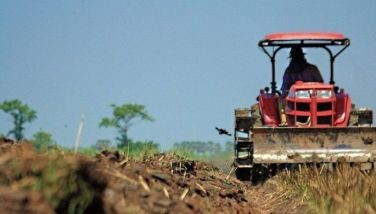Buffalo meat, anyone?
February 1, 2004 | 12:00am
Unknown to most Filipinos, tens of millions of consumers in more than 50 countries dine on buffalo meat from India everyday. But consumers in the Philippines can’t cook and eat it because the Department of Agriculture won’t let them. Indian buffalo meat is also known as carabeef.
In 1996, the DA suspended the importation of carabeef by meat traders, hotels and restaurants "in view of the representations made by the livestock raisers." The order effectively cut off access by consumers to a cheap source of protein.
At present, only DA-accredited meat processors are allowed to import carabeef as raw material in the manufacture of processed meat products such as corned beef, hot dogs or sausages.
Before the restriction, carabeef was served in hotels, restaurants and dinner tables in homes until the hog raisers took notice.
Because of its low fat and high protein content, carabeef has become a hit among health-conscious Europeans. It is lean with a fat content of less than 10 percent. By comparison, cattle beef has a fat content of more than 20 percent. Of course, in the Middle East and in other countries predominantly populated by Muslims, it is the main item on the menu.
Thus, the present government policy limiting carabeef as raw material for meat processing has no legal, moral or scientific basis at all. On the other hand, it discriminates against consumers who do not or cannot eat pork for various reasons. For instance, Muslims who are forbidden by their religion from taking any food with pork content are adversely affected by the restriction. Or those with health problems who need a high-protein diet.
It is thus timely for the administration of President Arroyo to promptly review the existing policy so that all sectors of society, including consumers and producers, will get fair treatment.
If the intent of the policy is to protect and promote the swine industry, there are other ways of doing so without sacrificing the welfare of consumers, both Christians and Muslims.
Furthermore, consumers should be given a break, especially at this time, when local meat prices have become prohibitive. With the introduction of carabeef into the local markets at a price of P90 per kilo or less, the meat supply situation can be stabilized. Prices of pork, chicken and beef have hit record highs since last year.
Consumers can be assured of stable carabeef prices because India has a huge population of buffaloes, now estimated at more than 92 million. The buffaloes are raised primarily for their milk and meat, and not as beasts of burden.
In India, especially in the provinces, most families raise buffaloes in their backyards to provide them with their daily milk supply. It is not unusual to see homes with four or five buffaloes on the front yard while vegetables are grown in the backyard. In fact, even the manure is collected and dried for use as fuel. When they are three or four years old, the buffaloes are sold to slaughterhouses which process them into meat for both domestic and export markets.
In comparison, the Philippines only has an estimated 2.4 million carabaos which will all disappear within three to four years if they are used for meat processing.
On various occasions, hog raisers have repeatedly claimed that their opposition to the continued importation of carabeef is their fear that it would transmit the FMD (foot and mouth disease) from India and threaten local livestock. They also blamed the FMD epidemic in 1994 on carabeef importation.
Both claims are without basis. No less than the Office International des Epizooties (OIE) declared that as long as the international trade on Indian buffalo meat follows the conditions set in the OIE Terrestrial Animal Health Code, there is no risk of transmission of the FMD virus to importing countries. The OIE, of which the Philippines is a member, is the only internationally recognized body of the World Trade Organization which deals with animal health and diseases.
The primary requirement of the OIE is that carabeef meat exports should be frozen, deboned and deglanded. By complying with this condition, India is able to export carabeef to more than 50 countries in Europe, the Middle East, Central and Southeast Asia.
On the 1994 FMD epidemic, the OIE had declared in a letter to the department of agriculture that the FMD virus did not come from India, but closely resembled those in Hong Kong and Taiwan.
As part of their lobbying efforts, hog raisers have also asked the government to pass a law that would allow meat imports only from FMD-free countries.
However, the proposal cannot be justified because at present, even FMD-free countries are importing carabeef from India. These include Italy, Germany, Netherlands, Belgium and Greece.
Among our neighbors, Singapore and the Malaysian states of Sabah and Sarawak which have been pronounced FMD-free zones by ASEAN, imports thousands of tons of carabeef annually.
If consumers are given direct access to carabeef, will it adversely affect the swine sector?
Admittedly, there could be some fallout. But considering the low per capita consumption of carabeef at less than 1.5 kilos per year as against 16 to 17 kilos for pork, the effect would not be significant.
Assuming for the sake of argument that the present import volume is doubled, it will only translate to less than three kilos per capita consumption per year. Even then, the inflow of carabeef imports will be self-correcting because of the foreign exchange situation.
Nevertheless, consumers should be given a choice on what food to eat and at what price to pay. After all, that is the essence of a democracy.
(Editor’s note: A former journalist, Sammy Senoren is now involved in the meat and food ingredient business. He has visited buffalo farms and modern slaughterhouses in India on several occasions.)
In 1996, the DA suspended the importation of carabeef by meat traders, hotels and restaurants "in view of the representations made by the livestock raisers." The order effectively cut off access by consumers to a cheap source of protein.
At present, only DA-accredited meat processors are allowed to import carabeef as raw material in the manufacture of processed meat products such as corned beef, hot dogs or sausages.
Before the restriction, carabeef was served in hotels, restaurants and dinner tables in homes until the hog raisers took notice.
Because of its low fat and high protein content, carabeef has become a hit among health-conscious Europeans. It is lean with a fat content of less than 10 percent. By comparison, cattle beef has a fat content of more than 20 percent. Of course, in the Middle East and in other countries predominantly populated by Muslims, it is the main item on the menu.
Thus, the present government policy limiting carabeef as raw material for meat processing has no legal, moral or scientific basis at all. On the other hand, it discriminates against consumers who do not or cannot eat pork for various reasons. For instance, Muslims who are forbidden by their religion from taking any food with pork content are adversely affected by the restriction. Or those with health problems who need a high-protein diet.
It is thus timely for the administration of President Arroyo to promptly review the existing policy so that all sectors of society, including consumers and producers, will get fair treatment.
If the intent of the policy is to protect and promote the swine industry, there are other ways of doing so without sacrificing the welfare of consumers, both Christians and Muslims.
Furthermore, consumers should be given a break, especially at this time, when local meat prices have become prohibitive. With the introduction of carabeef into the local markets at a price of P90 per kilo or less, the meat supply situation can be stabilized. Prices of pork, chicken and beef have hit record highs since last year.
Consumers can be assured of stable carabeef prices because India has a huge population of buffaloes, now estimated at more than 92 million. The buffaloes are raised primarily for their milk and meat, and not as beasts of burden.
In India, especially in the provinces, most families raise buffaloes in their backyards to provide them with their daily milk supply. It is not unusual to see homes with four or five buffaloes on the front yard while vegetables are grown in the backyard. In fact, even the manure is collected and dried for use as fuel. When they are three or four years old, the buffaloes are sold to slaughterhouses which process them into meat for both domestic and export markets.
In comparison, the Philippines only has an estimated 2.4 million carabaos which will all disappear within three to four years if they are used for meat processing.
On various occasions, hog raisers have repeatedly claimed that their opposition to the continued importation of carabeef is their fear that it would transmit the FMD (foot and mouth disease) from India and threaten local livestock. They also blamed the FMD epidemic in 1994 on carabeef importation.
Both claims are without basis. No less than the Office International des Epizooties (OIE) declared that as long as the international trade on Indian buffalo meat follows the conditions set in the OIE Terrestrial Animal Health Code, there is no risk of transmission of the FMD virus to importing countries. The OIE, of which the Philippines is a member, is the only internationally recognized body of the World Trade Organization which deals with animal health and diseases.
The primary requirement of the OIE is that carabeef meat exports should be frozen, deboned and deglanded. By complying with this condition, India is able to export carabeef to more than 50 countries in Europe, the Middle East, Central and Southeast Asia.
On the 1994 FMD epidemic, the OIE had declared in a letter to the department of agriculture that the FMD virus did not come from India, but closely resembled those in Hong Kong and Taiwan.
As part of their lobbying efforts, hog raisers have also asked the government to pass a law that would allow meat imports only from FMD-free countries.
However, the proposal cannot be justified because at present, even FMD-free countries are importing carabeef from India. These include Italy, Germany, Netherlands, Belgium and Greece.
Among our neighbors, Singapore and the Malaysian states of Sabah and Sarawak which have been pronounced FMD-free zones by ASEAN, imports thousands of tons of carabeef annually.
If consumers are given direct access to carabeef, will it adversely affect the swine sector?
Admittedly, there could be some fallout. But considering the low per capita consumption of carabeef at less than 1.5 kilos per year as against 16 to 17 kilos for pork, the effect would not be significant.
Assuming for the sake of argument that the present import volume is doubled, it will only translate to less than three kilos per capita consumption per year. Even then, the inflow of carabeef imports will be self-correcting because of the foreign exchange situation.
Nevertheless, consumers should be given a choice on what food to eat and at what price to pay. After all, that is the essence of a democracy.
(Editor’s note: A former journalist, Sammy Senoren is now involved in the meat and food ingredient business. He has visited buffalo farms and modern slaughterhouses in India on several occasions.)
BrandSpace Articles
<
>
- Latest
Latest
Latest
April 10, 2024 - 5:12pm
By Ian Laqui | April 10, 2024 - 5:12pm
March 4, 2024 - 3:32pm
By Ian Laqui | March 4, 2024 - 3:32pm
March 4, 2024 - 2:12pm
By Kristine Daguno-Bersamina | March 4, 2024 - 2:12pm
February 13, 2024 - 7:24pm
By Gaea Katreena Cabico | February 13, 2024 - 7:24pm
February 13, 2024 - 7:17pm
By Ian Laqui | February 13, 2024 - 7:17pm
Recommended



























